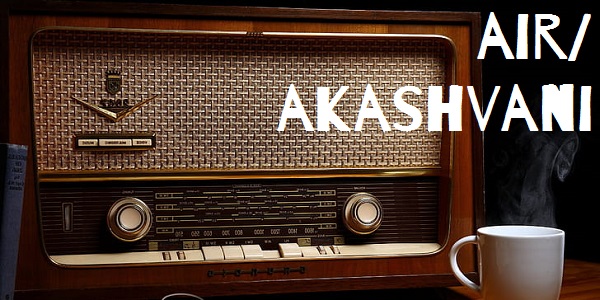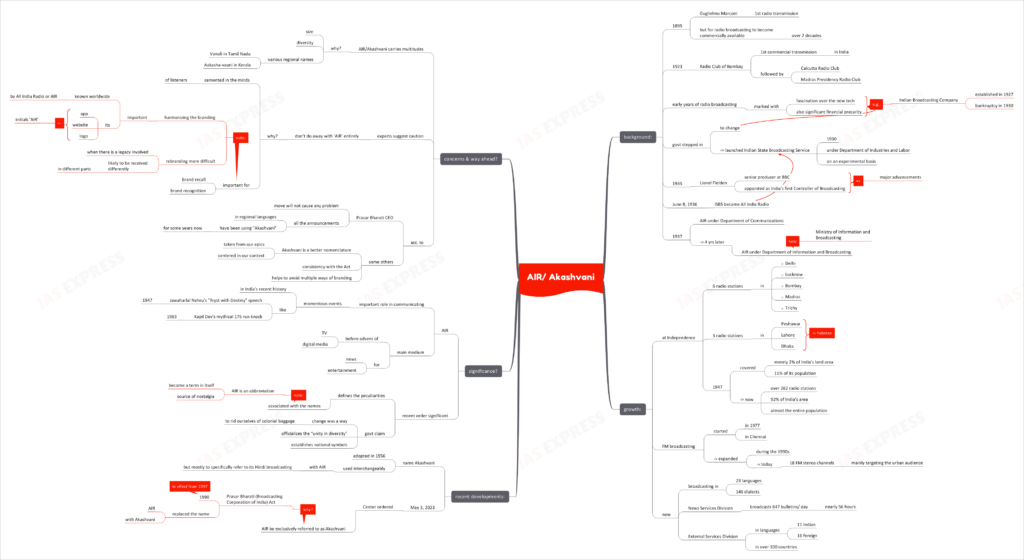All India Radio/ Akashvani- Background, Evolution & Significance

From Current Affairs Notes for UPSC » Editorials & In-depths » This topic
IAS EXPRESS Vs UPSC Prelims 2024: 85+ questions reflected
Recently, the government issued an order saying that AIR is to be henceforth referred to as Akashvani only. The move holds significance for the public broadcaster which had been a staple in millions of households in its heyday and still continues to reach the multitudes even in the remotest Indian hinterlands.

Background:
- In 1895, Guglielmo Marconi sent the 1st radio transmission. However, for radio broadcasting to become commercially available, it took over 2 decades after that.
- In 1923, the Radio Club of Bombay sent out the first commercial transmission in India, followed by the Calcutta Radio Club and the Madras Presidency Radio Club.
- While the early years of radio broadcasting were marked with fascination over the new technology, there was also significant financial precarity. For example, the Indian Broadcasting Company (IBC) was established in 1927 but faced bankruptcy in 1930.
- This changed only when the government stepped in. The Indian State Broadcasting Service (ISBS) was launched on an experimental basis in 1930 under the Department of Industries and Labour, providing a degree of stability in radio programming.
- In 1935, Lionel Fielden, a senior producer at BBC, was appointed as India’s first Controller of Broadcasting, and he brought major advancements.
- On June 8, 1936, ISBS became All India Radio (AIR).
- In 1937, AIR was brought under the purview of Department of Communications.
- Four years later, it was placed under the Department of Information and Broadcasting, (today’s Ministry of Information and Broadcasting), where it continues till date.
How has AIR grown?
- At the time of Independence, India had 6 radio stations. These were located in
- Delhi
- Lucknow
- Bombay
- Madras
- Trichy
- 3 radio stations – in Peshawar, Lahore and Dhaka – went to Pakistan.
- In 1947, AIR covered merely 2% of India’s land area and 11% of its population.
- AIR began its journey of growth to truly become All India Radio, expanding to over 262 radio stations across the country.
- Today, AIR is available to 92% of India’s area and almost the entire population, broadcasting in 23 languages and 146 dialects.
- Its News Services Division broadcasts 647 bulletins/ day for a total of nearly 56 hours.
- AIR also has an External Services Division broadcasting in 11 Indian and 16 foreign languages, covering over 100 countries.
- FM broadcasting started in 1977 in Chennai. It expanded during the 1990s and today, AIR has 18 FM stereo channels, mainly targeting the urban audience.
What are the recent developments?
- The AIR adopted the name Akashvani in 1956. Over the years, Akashvani was used interchangeably with AIR, but mostly to specifically refer to its Hindi broadcasting.
- On May 3, 2023, the Centre ordered that AIR be exclusively referred to as Akashvani in all broadcasts and programs.
- The order is in accordance with the Prasar Bharati (Broadcasting Corporation of India) Act, 1990, which replaced the name of AIR with Akashvani. This law came into being in 1997.
- The policy division of the public broadcaster has sent a message to all station heads to use the term Akashvani “wherever applicable in all announcements going on air” and to use the announcement “this is Akashvani in place of this is All India Radio” in English and other languages.
Why is this significant?
- AIR has had an important role in communicating momentous events in India’s recent history. Before the advent of TV and digital media, radio was the main medium through which news and entertainment were consumed.
- AIR brought iconic events like Jawaharlal Nehru’s “Tryst with Destiny” speech in 1947 or Kapil Dev’s mythical 175 run knock in 1983 to people across the country.
- The recent order is significant as it defines the peculiarities associated with the names. AIR is an abbreviation that has become a term in itself and a source of nostalgia for many Indians.
- The government has also claimed that the change was a way to rid ourselves of colonial baggage that may have persisted.
- The move officializes the “unity in diversity” that’s associated with AIR/Akashvani and establishes national symbols.
What are the concerns and way ahead?
- AIR’s contributions to the Indian media landscape cannot be overstated, and its legacy continues to this day as a trusted source of news, information and entertainment for millions of Indians.
- AIR/Akashvani carries multitudes given the size and diversity of the country it serves, and its various regional names like Vanoli in Tamil Nadu and Aakasha-vaani in Kerala.
- Some experts suggest caution and not doing away with ‘AIR’ entirely as it is cemented in the minds of listeners and important for brand recall and recognition.
- Harmonizing the branding is important as it is known worldwide by All India Radio or AIR and its app, website and logo have the initials ‘AIR’.
- Rebranding gets more difficult when there is a legacy involved and this move is likely to be received differently in different parts of the country.
- However, Prasar Bharati CEO recently said the move will not cause any problem, as all the announcements in regional languages have been using “Akashvani” for some years now.
- It is also argued that Akashvani is a better nomenclature as it is taken from our epics and is centred in our context, but it is difficult to obliterate the very first name (AIR) that is deeply ingrained in the minds.
- The move brings consistency with the Act and helps to avoid multiple ways of branding the broadcaster.
Practice Question for Mains:
Comment on the evolution and significance of AIR in India. Discuss the recent order to exclusively refer to it as Akashvani. (250 words)
If you like this post, please share your feedback in the comments section below so that we will upload more posts like this.

